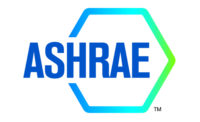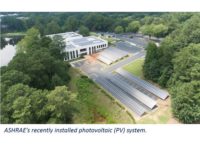A funny thing happened on the way to the “Should ASHRAE Pursue A Net-Zero Standard?” forum sponsored by ASHRAE TC 2.8 – Building Environmental Impacts & Sustainability. Well, not exactly — the funny thing was the way to the forum itself. This Sunday session seemed like a two-mile hike from the front door, thanks to the expansive and at times byzantine design of Caesars Palace and its conference center. Perhaps this location was a clever way to weed out any net-zero dilettantes and get down to the roughly 60 people who completed the journey and filled the room. The less committed may have given up and turned back, and some may have even fallen by the wayside if they did not pack adequate snacks or hire a Sherpa. (I’m not sure if there are any Sherpas for hire in Las Vegas … but would you bet against it?)
In accordance with the nature of ASHRAE forums, speakers did not have to give their names, and this article doesn’t cite any individuals. A variety of attitudes was represented, from those definitely interested in such a standard to those who brought more of an “inaction as default setting” position to the (very long, L-shaped) table. Actual decisionmaking was not part of the agenda; neither was forming a consensus on anything in particular. The only goal was gathering input and good questions to ponder at this preliminary phase on the long and winding road toward a potential standard, solicited from what was a noticeably diverse group.
With the stage set, let’s get on with a summary of the conversation about an optional net-zero standard. The overview is more like a stream of consciousness at times, but it will give you a sense of the room’s thinking and the formidable task that could await the committee. Rather than tackling the comments chronologically, I’ll split the input into a few basic categories, starting with …
Definitions
Which definition of net-zero energy should be used? International definitions vary. The definition and its repercussions can also vary how far you go up/back the energy chain. Members cited a couple of examples (including moving data processing to the cloud, which elicited some knowing chuckles) where energy use may be decreased at the building itself but is really just shifted to somewhere off-site. How should that energy count?
Also, a net-zero definition needs to be coordinated with the real estate market and its understanding of the term as it works with client interests.
Concerns
Standardizing might restrict currently innovative net-zero designers. We don’t want to hamper flexibility.
What would such a standard require vis a vis benchmarks and measurement? Maybe that’s a next-level question.
You can have two net-zero buildings with different EUIs.
Similarly, what happens when the measurement doesn’t come up zero kW? Does the owner sue? Or might a tenant sue? Related, what if it’s simply an unseasonably hot year?
Members cited a couple of examples (including moving data processing to the cloud, which elicited some knowing chuckles) where energy use may be decreased at the building itself but is really just shifted to somewhere off-site. How should that energy count?That led the group to a key subtopic: Would such a standard be design-oriented or performance-oriented? It was noted that Standard 90.1 is design-oriented, but that alone didn’t feel like that would be entirely satisfactory (for this crowd, anyway). Still, a member pointed out that extending responsibility past the granting of the occupancy certificate can be a “hornet’s nest,” wondering how that handoff can be improved.
Furthermore, what if the owner usage predictions are way off on the front end? Then the design is immediately off, through little to no fault of the design team.
Some ideas ensued. Perhaps the standard is design-oriented but is coordinated with a separate effort focused on O&M for net-zero buildings. Another attendee pointed out that parts of Europe use “dynamic labeling” for communicating a building’s performance, reflecting actual consumption on an updated/ongoing basis.
Another thought: a net-zero standard with tiers. In this scenario, Tier 1 might address the model and design, while Tier 2 deals with O&M, verified usage, etc.
Guideline Or Standard (Or Both)?
One classic issue is the matter of technology perpetually staying ahead of codes, and the resulting challenges for those who write, enforce, and try to adhere to those codes while also trying to deliver optimal solutions for clients.
It’s easier to start a guideline committee, and that can always step up to standard committee. A member added that starting as a guideline also helps to flush out some unintended consequences of the effort.
Some uncertainty arose about the practical difference in creating a standard versus a guideline. Both go through public review, it was clarified, but both the process and the language differ.
One other question: Does this belong standalone or as part of something else like 189?
Devil’s Advocacy
Someone asked: What’s so special about the “zero” in net-zero? Well, another attendee replied, you could question the selection of any target level. That’s not a reason to avoid any or all given targets.
What if the owner usage predictions are way off on the front end? Then the design is immediately off. Perhaps, someone suggested, the standard is design-oriented but is coordinated with a separate effort focused on net zero O&M.Existing policy and regulatory hurdles are prominent, an engineer noted, not to mention possible political complications. State regulations could hang you up by prohibiting certain methods or tactics.
At one point, the more conservative edge of the group’s viewpoints did come through plainly: There’s enough guidance out there already, a member said. No need for a standard. Later in the forum, someone else did point out that such a standard would be optional, after all.
An especially interesting comment: The first response to a test is trying to figure out how to break the test. One example offered: project teams have in some cases become over-reliant on things like bike racks to boost their points, etc., and there were nods of agreement around the room.
Further down the sequence of events in a net-zero standard scenario, perhaps the “year” or relevant timeframe for measurement and verification is approaching its end, and the building is not on pace to meet its goals. At that point, an owner might even sacrifice occupant comfort in the short-term in order to achieve compliance.
(That scenario might or might not be particularly likely, but it’s unattractive nonetheless. It does illustrate how extending the standard’s purview beyond design to performance may have rationales that are both logical and noble while exposing the effort to new pitfalls relating to operations and beyond. Side note: A participant confirmed that an installment in ASHRAE’s ongoing Advanced Design Guide series is underway for net-zero K-12 school design.)
One noteworthy change is visible right on the map. The United States climate zones have been updated to reflect current data, and as a result, 10% of counties in the U.S. have been assigned to a warmer zone than before.Upon the conclusion of what was a cordial and thought-provoking forum, the group slowly filed out of the room and into the main hallway, where people lingered to discuss the discussion, talk about dinner plans, and tape their feet for the trek back to the hotel lobby.
NIPS & TUCKS FOR 90.1
The next day, the business week in Las Vegas (sounds like an oxymoron, I know) started bright and early. The traditional Monday ASHRAE press breakfast served up not only a surprising egg dish with an Italian twist but also an in-depth look at last year’s updates to ANSI/ASHRAE/IES Standard 90.1 (Energy Standard for Buildings Except Low-Rise Residential Buildings). Bing Liu and Michael Rosenberg of Pacific Northwest National Laboratory (PNNL) were on hand to deliver their substantial overview of the team’s work and then take some questions.
For starters, they outlined a few emphases that drove the decisionmaking behind recent adjustments, affecting not only the content but also the presentation of the standard:
-
ANSI consensus
-
Save energy in technically feasible ways
-
Shift toward e-reading
-
Ease of use
-
Changes measured in terms of whole-building performance (a more challenging metric because it incorporates things like plug load and process loads)
Highlights
One noteworthy change is visible right on the map. The United States climate zones have been updated to reflect current data, and as a result, 10% of counties in the U.S. have been assigned to a warmer zone than before. On the facility upside, they noted, this may result in less insulation in certain spaces.
Some of the key updates were more HVAC-related than directly HVAC oriented. The part of the standard addressing the building envelope saw changes, with window U factors/values receiving an update. Whole building air leakage testing was added as optional, while air barrier verification is now required.
Getting into key HVAC system specifics, DOAS units are now covered by 90.1 for the first time. In another meaningful change, replacement equipment is now subject to many requirements that had previously only applied to new equipment.
Sensors
An increased emphasis on efficiency gains through the use of sensors became apparent through the presentation. Hotel room occupancy sensors will now be required, for one example. Moreover, they should use both short- and long-term settings, allowing hotels to adjust differently depending on whether the guest is simply gone for a while or whether a guest room is between reservations altogether and can fall back yet further to a more aggressive default.
Moreover, hotel room sensors should use short- and long-term settings, accounting for whether the guest is simply gone for a while or whether a guest room is between reservations altogether and can fall back to a more aggressive default.Occupancy sensors also showed up on the commercial side, where 50% of wall receptacles should incorporate occupancy sensors, which would seem to require some more advanced occupant planning about what is plugged into where. Parking lot lighting is another area where increased sensor use comes into play.
Overall, changes in the lighting-related language represent the biggest expected energy reduction out of all 121 addenda. The lighting power allowance is down 25-30%, according to the presenters, primarily on the shoulders of LED lights as they have become more viable in indoor, outdoor, and retail environments.
The Path Now Taken
While 90.1 had offered two compliance path choices — prescriptive or energy cost budget (ECB) — designers can now also opt for the Performance Rating Method in Appendix G. Rosenberg describes it as like the ECB approach but offering more flexibility, in part by rewarding design choices not credited in the previous two methods. The state of New York is already using this approach as part of its own code, and Rosenberg mentioned that LEED is also trying it out on a trial basis.
Lighting revisions account for a major part of the 2014 improvements, but Liu and Rosenberg said savings could have gone even further via mandated LED lighting. That option was tabled but remains on the radar for 2019.
One big anticipated positive is an environment where designers can deploy a single modeling method to use toward multiple code/program requirements. Furthermore, the Society hopes that this newfound unity on the modeling/requirements front will encourage a fresh wave of software development and improvements.
Savers & Big Gainers
Having run energy savings analyses for different types of applications, comparing the 2004 and 2016 versions of the standard, they expect the biggest efficiency gainers under the new version to be outpatient healthcare facilities, hospitals, and large hotels, in that order.
As you would expect, most spaces’ energy allowances went down, but a couple did go up. Senior centers are one example, on account of increased lighting recommendations.
While lighting-related revisions account for a major part of the 2016 improvements, Liu and Rosenberg said savings could have gone even further via mandated LED lighting. That option was tabled but remains on the radar for 2019.
On The Horizon
While we’re looking down the road, what else should engineers expect (or at least consider as possibilities) from the next update? According to Liu and Rosenberg, here are a few areas that could be targeted the next time around:
- Continued focus on sensors and occupancy, building on recent hotel room changes
- Air barrier testing
- Increased emphasis on commissioning
- Identifying and addressing major professional barriers to designing to the standard
- Increased requirements relating to heat recovery/reuse
- Expanded scope of the standard to tackle more industrial settings, similar to computer rooms in past revisions
- Overall savings of 40-45% compared to 2004 levels
- Effort to respect the process that clients face in their own operations
That last item provided some worthy context. After all, they noted, if incorporating improvements creates too much of a disruption in the client’s daily business, you could pretty quickly undo a year’s worth of energy savings for the owner before you’ve started.
Beverly is Engineered Systems’ editor. Reach him at beverlyr@bnpmedia.com.





